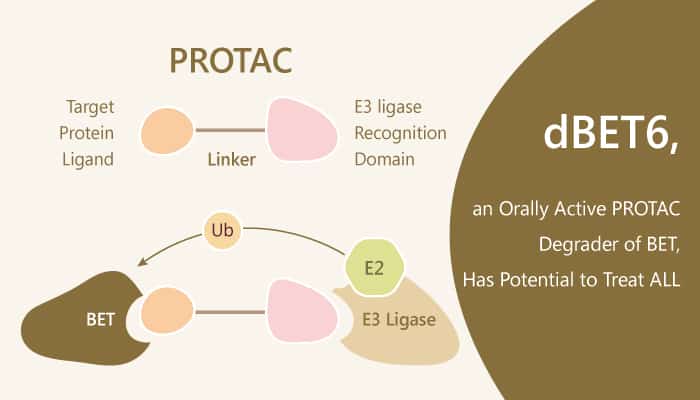Development of drugs based on PROTAC is not new to us. We have mentioned the technology many times in our blogs. PROTAC is used to move the unwanted proteins to treat terrible diseases, especially various kinds of cancer.
Today, we will talk about another PROTAC agent used in the research of T cell acute lymphoblastic leukemia (T-ALL).
dBET6 is a highly potent and second-generation degrader of BET bromodomain. It is composed of a BET inhibitor, a ligand of E3 ubiquitin ligase cereblon and a linker. The compound exhibits excellent cellular potency.

In the process of discovering new PROTAC drugs, researchers compared dBET6 to dBET1. They share similar binding affinity to BRD4 bromodomain 1 (BRD4(1)). This can’t prove the superior of dBET6. However, in CRBN-deficient cells, dBET6 shows more effective activity than dBET1. Moreover, dBET6 is significantly cytotoxic in cancer cells than dBET1 and other related compounds.
In T-ALL lines, dBET6 (100 nM) causes depletion of BRD4 after treatment for 1 hour. But it can’t degrade BET protein or produce cytotoxicity without CRBN. This indicates that dBET6 is dependent on CRBN. dBET6 decrease mRNA levels and collapses core transcriptional circuitry of T-ALL.
In addition, dBET6 displays dramatic activity in a mouse model bearing T-ALL. As a result, dBET6 shows obvious survival benefit at a dose of 7.5 mg/kg.
dBET6 is a potent PROTAC degrader of BET with anti-T cell acute lymphoblastic leukemia activity. We need further study to explore more potential of dBET6.
References:
1. Winter GE, et al. Mol Cell. 2017 Jul 6;67(1):5-18.e19.